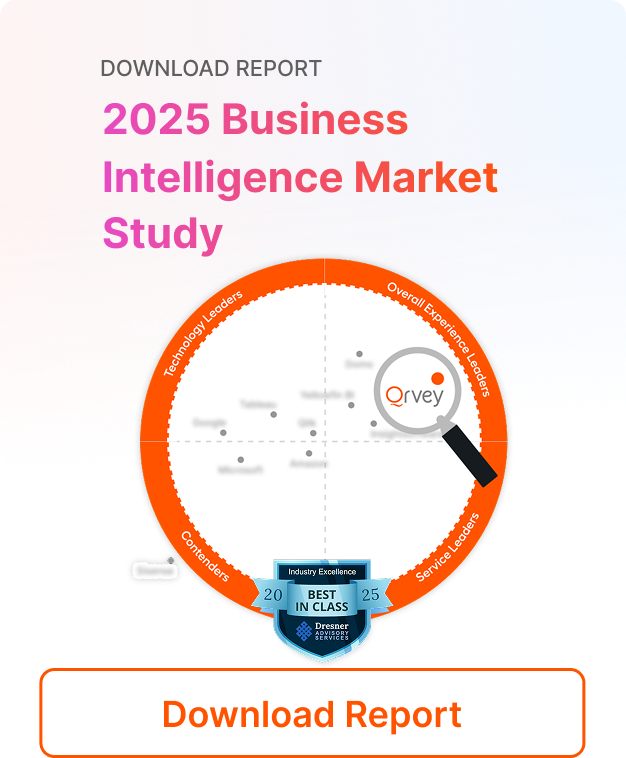
⚡Key Takeaways
- Embedded analytics integrates data insights directly into your application workflow, eliminating the productivity drain of switching between multiple tools
- A purpose-built analytics platform like Qrvey helps you avoid costly in-house builds by offering a multi-tenant architecture, advanced visualization capabilities, and white-label control for seamless integration
- When embedded correctly, analytics create new revenue streams & improve customer service.
Users get frustrated when they can’t access insights without exporting data or chasing down reports. The fix is embedding analytics in modern applications, a way to deliver dashboards, visualizations, and reporting directly inside your product.
This article walks you through everything: why embedding is essential, how it improves user experience, and the best practices for integrating analytics.
We’ll also explore real-world SaaS examples, pitfalls to avoid, and the future of embedded analytics. You’ll also see how solutions like Qrvey give you speed, flexibility, and full white-label control.
What is Embedded Analytics?
Embedded analytics means building data visualizations and reporting directly into your existing application interface. Your users see charts, dashboards, and insights without ever leaving their workflow to visit separate BI tools.
Instead of having a “Reports” section that feels disconnected, your analytics become part of every relevant screen. A project manager sees budget performance right within the project dashboard. A sales rep views pipeline metrics embedded in their CRM workflow.
TechTarget explains that when “data analysis features are embedded in familiar applications, it encourages user adoption of analytics and reduces the need for specialized BI training.” This happens because users interact with sophisticated business intelligence technology without realizing they’re using complex analytical tools.
Why Embed Analytics in Modern Applications?
What happens when great analytics hide behind poor user experience?
Boris Evelson from Forrester Research found that despite decades of “user-friendly” improvements, only 20% of enterprise decision-makers actually use BI tools hands-on. The remaining 80% still depend on analysts for data sourcing, integration, and insights delivery.
This bottleneck disappears when you embed analytics directly where decisions happen.
Enhanced User Experience
JobNimbus discovered this firsthand when they faced churn among large enterprise customers. Their legacy reporting modules were inflexible, and customers couldn’t get the visibility they needed to run projects effectively.
After deploying Qrvey’s embedded analytics, everything changed. Within months, they achieved 70% adoption among targeted enterprise users and saw a meaningful increase in their product market fit score.
“We can’t speak highly enough of the stellar team at Qrvey; their dedication is something we truly value”
Ryan Q, Senior Product Manager at Job Nimbus
Most importantly, they eliminated customer churn that was previously caused by reporting limitations.
The difference is their analytics finally felt like a natural part of project management instead of a separate tool to learn.
Competitive Differentiation
“Analytics is in that must-have category,” explains Natan Cohen, Customer Success Lead at Qrvey. “Most companies discover they can’t treat it as nice-to-have anymore.”
When your competitors force users to export data to Excel but you provide rich, interactive insights embedded in context, you’re creating a competitive moat that’s difficult to replicate.
David Abramson, CTO at Qrvey, puts it best: embedded analytics allows you to “define new revenue opportunities” while helping you “differentiate against competitors” by delivering capabilities faster while maintaining security and scalability.
Cost Efficiency and Speed to Market
Building comprehensive analytics in-house typically requires data lakes, semantic layers, custom connectors, and specialized expertise your team likely lacks.
Poor data quality alone costs organizations an average of $12.9 million while companies spend an average of $208,000 annually just on data quality tools.
Purpose-built embedded solutions eliminate these costs while dramatically reducing time to market. As Abramson notes, “It can be as quick as a couple of weeks to build that proof of concept and then even maybe just a few more weeks to launch that initial MVP.”
Key Principles & Practices for Effective Embedded Analytics
Great embedded analytics doesn’t equal cramming more features into your interface. Delivering the right insights at the right moment is what does it.
Design for Context
Your analytics should answer the specific questions users have at each point in their workflow. A sales manager reviewing team performance needs different insights than an individual rep working a specific deal.
This contextual approach requires understanding your user personas deeply.

Indeed, 88% of customers expect self-service capabilities within applications but that doesn’t mean overwhelming them with every possible metric.
Prioritize Self-Service
The magic happens when users can explore their data independently without requiring developer intervention for every new question.
Intuitive analytics platforms like Qrvey provide interfaces that let users filter, drill down, and create custom views while maintaining appropriate security boundaries and data governance.
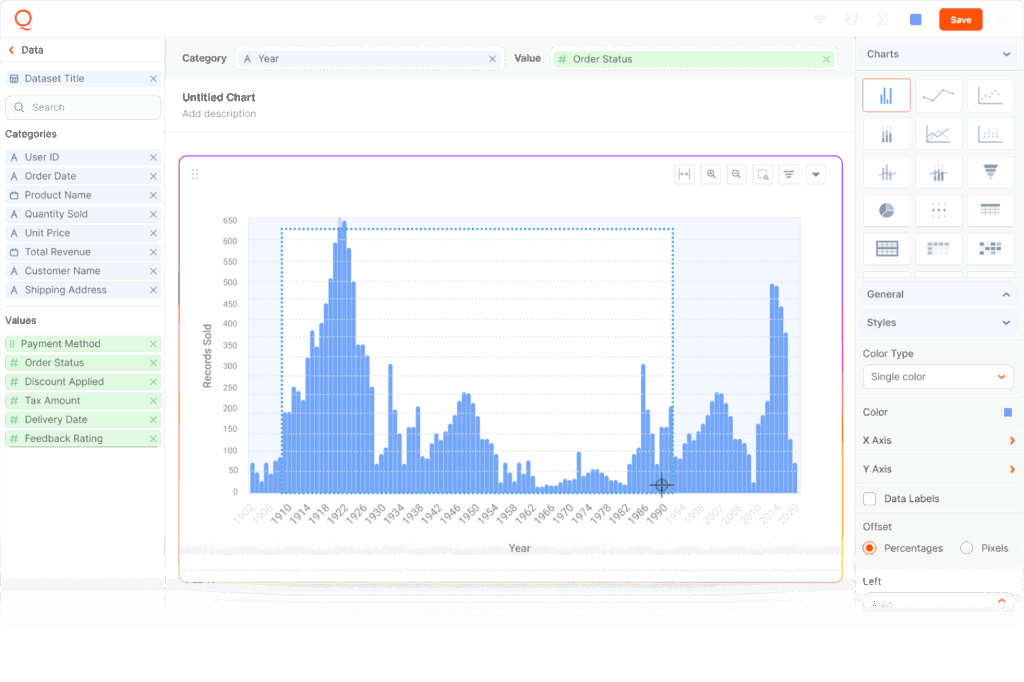
Maintain Native Feel
The best embedded analytics should inherit your application’s design system, color schemes, and interaction patterns seamlessly.
This means avoiding iframe-based solutions that create obvious breaks in your interface. Instead, choose modern data analytics solutions that offer true embedding capabilities through JavaScript widgets that feel like native components.

How to Integrate Analytics into Your Application
The path to successful implementation varies depending on your technical constraints and user needs, but the fundamental steps remain consistent across successful deployments.
Start with Your Biggest Pain Point
Identify the single most frustrating limitation your users face, typically the feature generating the most support requests or causing the most churn risk.
This approach ensures you’re solving real problems rather than building features that look impressive but don’t drive adoption.
Choose Your Architecture Carefully
Modern cloud-native applications offer advantages that traditional on-premise solutions can’t match. Serverless technologies like Functions as a Service (FaaS) and Backend as a Service (BaaS) enable applications to scale automatically based on demand.
Plan for Multi-Tenant Security from Day One
94% of buyers leave if they’re not guaranteed data protection so building a SaaS platform means multi-tenant security isn’t optional. And not just between tenants but within tenants to ensure users only see data they should access.
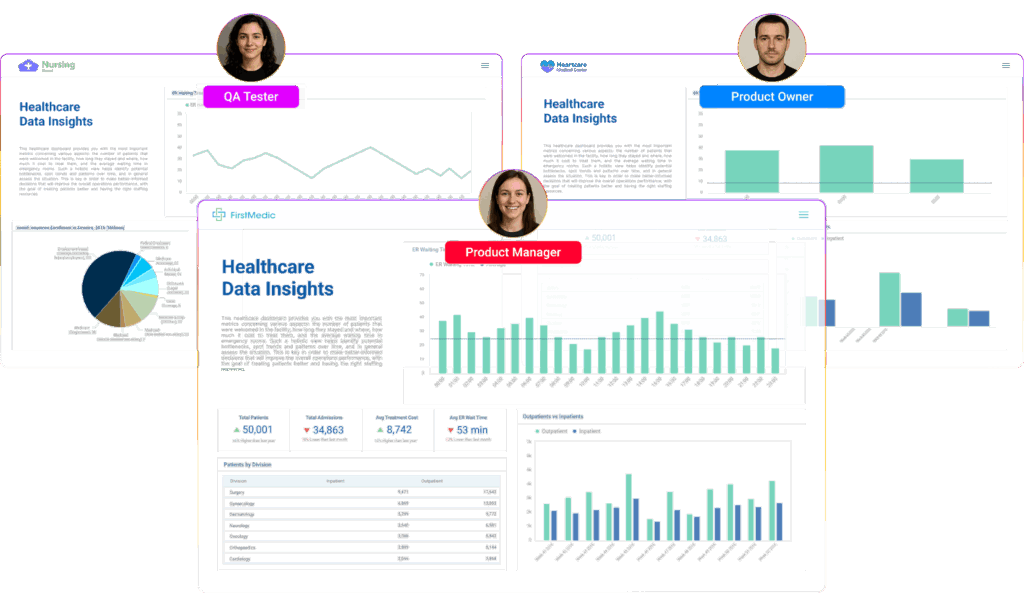
This requires row-level security that automatically filters data based on user permissions without requiring complex logic in your application code.
Examples of Embedded Analytics in Applications
Real-world examples illustrate how different industries approach analytics integration and the business outcomes they achieve.
Download our FREE Embedded Analytics Product Fit Guide to see how these principles apply to your specific situation
SaaS Platforms
Modern SaaS companies embed analytics to differentiate their offerings. Instead of providing basic reporting, they integrate insights that help customers make better business decisions.
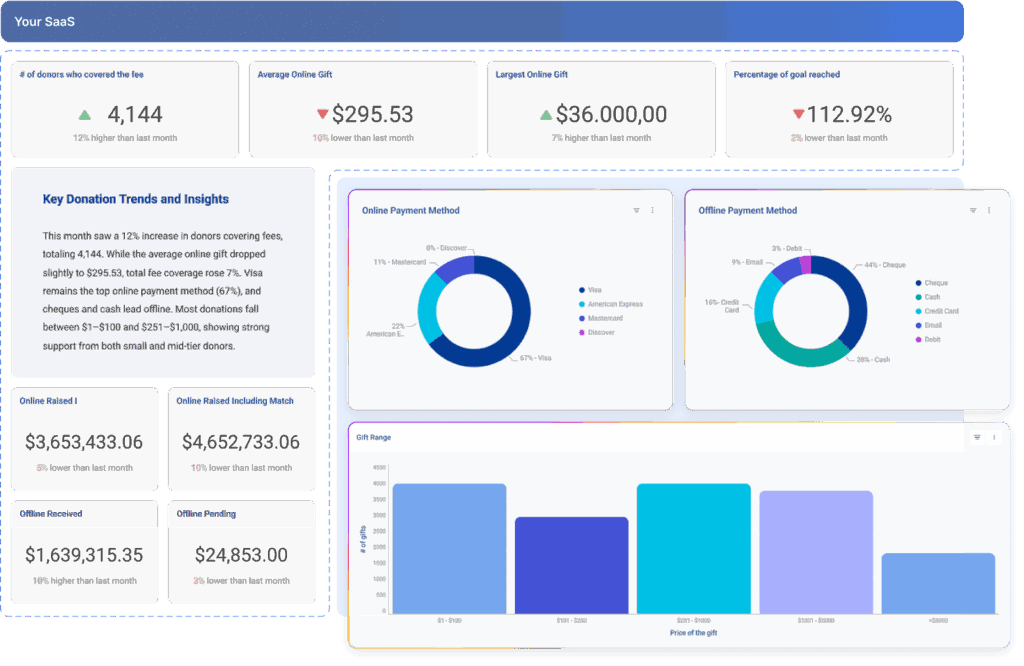
When customers rely on your embedded insights for daily decisions, switching to competitors becomes significantly more difficult.
Healthcare
Healthcare applications embed risk scores and outcome predictions directly into patient records. Clinicians see analytical insights without interrupting their workflow, leading to better patient outcomes and faster decision-making.

Lindsay Stares captures the core principle: “The idea is to bring data and analysis capabilities directly to business users rather than having all insights come through IT.”
The key insight here is timing. Analytics become most valuable when they appear exactly when decisions need to be made.
How to Choose the Right Embedded Analytics Platform
The wrong platform choice results in months of integration headaches and user experiences that feel disconnected from your application.
Scalability That Matches Your Growth
Your platform choice today determines whether you’ll face painful migrations as you grow. Look for solutions built on modern architectures that can handle increasing data volumes and user concurrency without degrading performance.
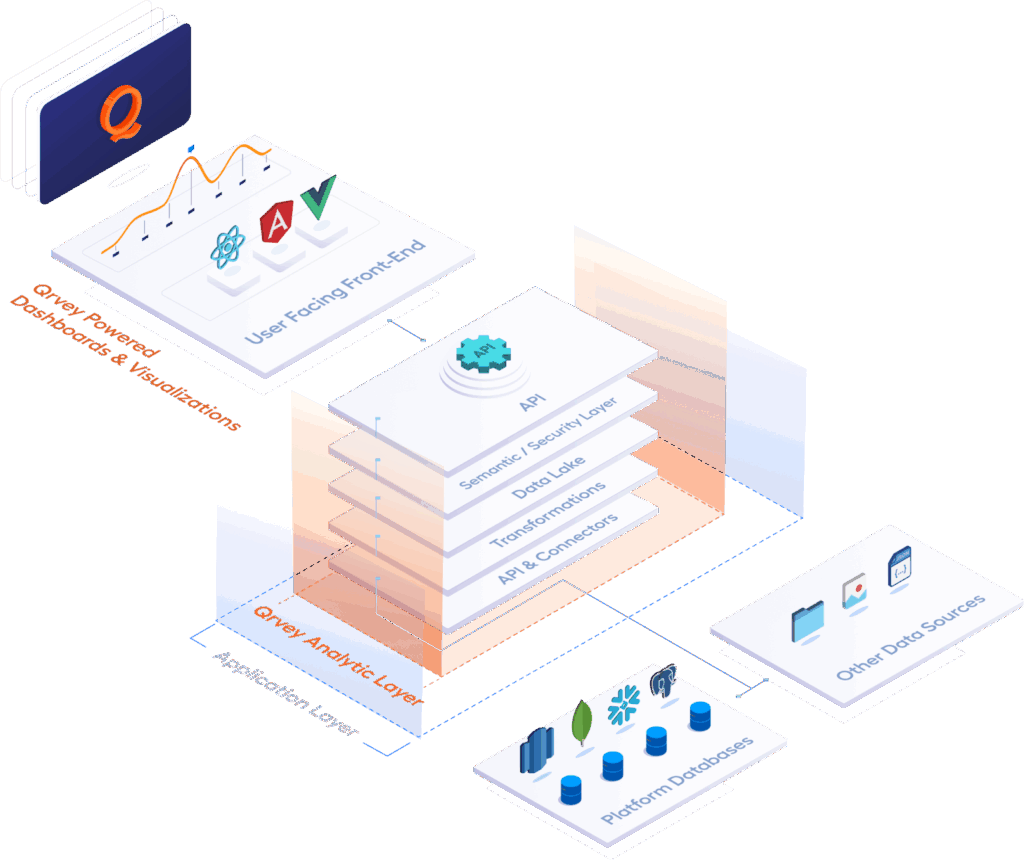
Qrvey’s approach exemplifies this with our built-in data lake designed specifically for multi-tenant analytics, combined with security controls at tenant, user, and data levels.
Demo Qrvey to see how proper architecture supports long-term growth.
Native Integration
Avoid platforms that rely heavily on iframes, which create jarring user experience breaks and often fail to inherit your application’s authentication or design systems.
Look for SDK-first approaches that let you embed analytics as native components. Qrvey exemplifies this approach with JavaScript-based widgets that integrate seamlessly without iframes, preserving your application’s native experience while delivering enterprise functionality.
Consider Self-Service Requirements
Your users increasingly expect to create their own reports and dashboards. The platform should provide intuitive self-service capabilities that reduce demands on your development team while maintaining security boundaries.
When self-service tools are implemented correctly, about 80% of reports can be created by end users without technical team involvement. This dramatically reduces your analytics backlog while increasing user satisfaction.
Future Trends in Embedded Analytics
Understanding where the industry is headed helps you make platform choices that won’t become obsolete quickly.
John McGuigan from Infragistics predicts that “the future of embedded analytics will be defined by its increasing intelligence, accessibility, and integration into everyday business processes.” This evolution includes several key areas:
- AI integration is accelerating rapidly. Global AI in SaaS market size would bring in $2973.14 billion by 2034. This includes developer productivity tools, AI-powered insights for power users, and chat-like interfaces for basic users who prefer asking questions in natural language rather than building dashboards.
- Mobile optimization becomes critical as mobile devices account for 62.54% of global website traffic. Your embedded analytics must work flawlessly across all devices.
- Edge analytics will grow alongside IoT expansion, enabling real-time insights on devices without cloud round-trips for ultra-low latency requirements.
Embed Analytics Seamlessly with Qrvey
The difference between analytics that transform user experiences and those that get ignored often comes down to implementation approach.
Qrvey’s embedded analytics platform provides everything you need: a built-in data lake analytics, multi-tenant security, embeddable JavaScript widgets, and self-service dashboard that work seamlessly within your existing application.
Plus implementation in weeks means you can start delivering value to users quickly while maintaining the flexibility to expand capabilities over time.
Demo Qrvey today or explore pricing options that fit your growth stage

David is the Chief Technology Officer at Qrvey, the leading provider of embedded analytics software for B2B SaaS companies. With extensive experience in software development and a passion for innovation, David plays a pivotal role in helping companies successfully transition from traditional reporting features to highly customizable analytics experiences that delight SaaS end-users.
Drawing from his deep technical expertise and industry insights, David leads Qrvey’s engineering team in developing cutting-edge analytics solutions that empower product teams to seamlessly integrate robust data visualizations and interactive dashboards into their applications. His commitment to staying ahead of the curve ensures that Qrvey’s platform continuously evolves to meet the ever-changing needs of the SaaS industry.
David shares his wealth of knowledge and best practices on topics related to embedded analytics, data visualization, and the technical considerations involved in building data-driven SaaS products.
Popular Posts
Why is Multi-Tenant Analytics So Hard?
BLOG
Creating performant, secure, and scalable multi-tenant analytics requires overcoming steep engineering challenges that stretch the limits of...
How We Define Embedded Analytics
BLOG
Embedded analytics comes in many forms, but at Qrvey we focus exclusively on embedded analytics for SaaS applications. Discover the differences here...
White Labeling Your Analytics for Success
BLOG
When using third party analytics software you want it to blend in seamlessly to your application. Learn more on how and why this is important for user experience.





